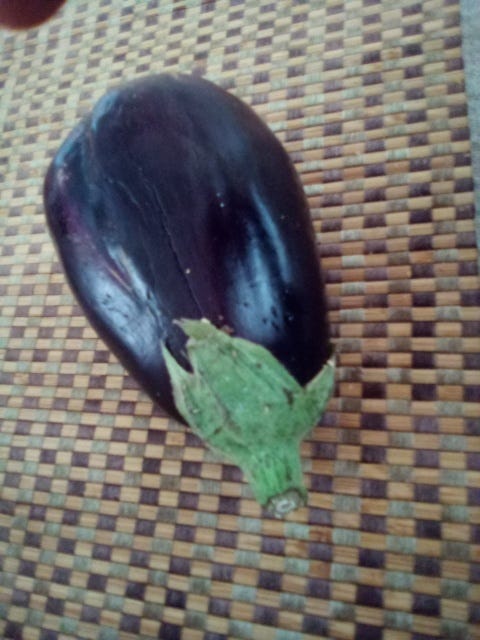Gardening: making the world a better place one backyard at a time
The time for a national gardening program is now
This issue of The Green Dispatch is another “News You Can Use”, meant to help you to lower your carbon footprint or to otherwise lead a more environmentally sound lifestyle.
As with other “News You Can Use,” I try to find ways that you can help the planet that can also save you money, be a healthful part of your life, or might be kind of fun. This week’s NYCU, home gardening, is all three. Gardening can be economical, bring you tasty and nutritious fruits and vegetables, and can be some of the most fun you can have around the house, all while you lower your carbon footprint.
I was going to save this posting for springtime, but late summer/early fall is a good time to think about gardening for next spring, a time when you can start your compost bin, plan where in your yard you want to put your garden, and strategize what you’re planting and when.
Bring down emissions with every strawberry, tomato, or kohlrabi from your garden
Research from the University of California Santa Barbara, published in the journal Landscape and Urban Planning in 2017, found that there are multiple ways that a home garden reduces greenhouse gas emissions. None of them are slam dunk, save-the-planet reductions, but added together the lowered emissions reach some significance. I’m skeptical about one of the reasons the researchers give for the GHG reductions, that when folks are out in their gardens they aren’t inside and using the air conditioning. Every gardener I know keeps the AC cranked, so they have a nice cool place waiting for them when they finish up with their chores. But let’s get to what might really work.
No trucking was involved for the rutabaga grown outside your window sill. It was not refrigerated, nor was it wrapped up in plastic at the grocery store. All of these contribute just a small amount of GHG per rutabaga or any other vegetable, but added together, we’re starting to get to some emissions savings.
The researchers’ model was reliant on home gardeners composting kitchen and garden waste. Kitchen scraps that wind up in landfill can release a lot of methane as they rot, and a molecule of methane can collect 25 times the heat that a molecule of CO2 can collect. The researchers estimate that home gardeners that compost reduce their produce’s GHG output by 17 percent
.
We could assume that lawns are carbon sinks, and they could be if it weren’t for lawn maintenance, which is usually reliant on mowers, leaf blowers, and commercial fertilizers. These things turn lawns into net carbon producers. Converting lawn to garden thus reduces emissions, and the authors included GHG savings from this conversion. Adding all the savings together, they found that backyard or urban gardens reduced GHG output by 2.1 pounds of CO2 equivalent per pound of produce. If your small garden plot produces about 100 pounds of potatoes, bok choy, squash, onions, tomatoes, and garlic, then more than 200 pounds of CO2 or its equivalent were kept out of the atmosphere.
Government’s role
In the grand scheme, 200 pounds of GHG is not significant, but the authors say that on a grand scale, if lots of folks adopted gardening, it could amount to a sizable dent in our emissions. The federal government has encouraged Americans to plant gardens before, always during crises. During World War I the government sponsored Liberty Gardens, Relief Gardens during the Great Depression, and Victory Gardens during World War II, the largest and most successful program being the Victory Gardens. The wreckage of Pearl Harbor was still smoldering when the Claude Wickard, Secretary of Agriculture, held a news conference laying out the Victory Gardens program. Other federal agencies and state governments became involved as well. The National Institute of Municipalities made model ordinances for cities and municipalities, and almost all of the 48 states formed their own Victory Garden Committees.1
Besides the government promoting gardening, businesses and volunteer organizations took part in the Victory Gardens effort. Westinghouse, for example, promoted the Health Through Victory Club, with radio shows and advertisements and sponsored employee gardening clubs by donating land for gardens. Magazines, including House and Garden and Better Homes and Gardens, printed advertising and featured articles with such titles as “Knotty Problems that Confront Victory Gardeners”.2
The campaign was extremely successful. During the war,the U.S. Department of Agriculture estimated that half the families in the country cultivated Victory Gardens, resulting in more than 20,000,000 gardens that put into productive yield about 4,000,000 acres—a total landmass greater than the state of Connecticut. (And remember, the population of the U.S. during WWII was about one third of what it is today.) Although drought brought failures in Oklahoma, portions of Texas, and the Washington, DC, area, the rest of country enjoyed a bounty. The combined amount of food produced from the Victory Gardens totaled 8,000,000 tons, enough to feed the entire U.S. Army, or about 125 pounds of produce for every man woman and child in the U.S.3 This immense productivity was achieved before the use of industrial fertilizers and other “green revolution” technologies.
With the way things are now, with the politics even played over something so politically neutral as Michelle Obama planting a garden at the White House, I have a hard time envisioning a program as successful as the WWII Victory Gardens. Political insanity aside, gardening on a massive scale would eat into profits of farmers, suppliers, grocery stores, and possibly even restaurants. The possible lobbying and resistance from these businesses could be formidable. Yet the present crisis is a greater threat that that posed during WWII, and the carbon savings from a program similar to Victory Gardens could be sizable. Now is the time for Uncle Sam to tell folks: “I want you to plant your garden!”
News of the week
Conservation News highlights the plight of the Gullah Geechee, people of west African descent who have lived for generations along the banks of the Atlantic from North Carolina to Florida. Encroachment from development and sea level rise now threaten their homes and unique life and language. Along with government agencies and NGOs, the Gullah Geechee communities are restoring marshland and oyster reefs as barriers to sea level rise.
According to the U.S. Geological Survey, the population of the Atlantic sturgeon may have declined by 99 percent since the 1800s. Hundreds of thousands are believed to have spawned in 35 rivers in the United States and Canada. Recent surveys estimate that fewer than 250 adults were found in 22 rivers. Prized for the caviar they produced, overfishing is blamed for their decline, along with habitat degradation, poor water quality, and being caught as bycatch.
Wednesday marked the 45th anniversary of Jimmy Carter signing into law the Surface Mining Control and Reclamation Act (SMCRA). The tone at the Office of Surface Mining Reclamation and Enforcement was, as one might expect, congratulatory, saying in their press release:
Over the last 45 years, SMCRA has directly contributed to the closure of more than 45,000 abandoned underground mine shafts and openings; regraded nearly 1,100 miles of highwalls; and rehabilitated more than 1,500 miles of clogged streams. All of this has improved health, safety, and economic conditions in mining communities.
This masks what the legislation allowed, mountaintop removal. At the time of its passage, it was thought that the massive mining practice might lead to a handful of operations. Over the last 45 years, however, hundreds of such mines have extracted coal from Appalachia, destroying thousands of miles of valleys and streams. Communities have suffered as well. In an email, Vernon Haltom, the Executive Director of Coal River Mountain Watch, an organization that advocates for the people and the environment of Appalachia, had this to say:
On this 45th anniversary of the signing of the Surface Mining Control and Reclamation Act, the Appalachian communities devastated by floods should be a startling testimony to the failures of SMCRA and the failures of the federal Office of Surface Mining, Reclamation and Enforcement. Where the forest canopy, understory, topsoil, and natural contours are eliminated by mountaintop removal coal mining, heavy rainfall has no natural buffer, and flooding is worse. The hundreds of coal waste slurry dams, the sediment ponds, and the valley fills create more concern as potentially ticking time bombs for catastrophic failure. And weak enforcement and poor planning by OSMRE and state agencies have allowed coal operators to walk away from reclamation obligations or leave barren sites idle for years. These processes should have never been allowed, but the present catastrophes should scream out for an end to mountaintop removal.
For more environmental science & news follow me on Twitter @EcoScripsit.
Bassett, T. "Reaping on the margins: A century of community gardening in America." Landscape 25.2 (1981): 1-8.
Miller, C. "In the sweat of our brow: Citizenship in American domestic practice during WWII — Victory Gardens." Journal of American Culture 26.3 (2003): 395-409.
1999 Statistical Abstract Highlights 20th Century Changes” United States Department of Commerce. Economics and Statistics Administration. Bureau of the Census Dec. 13, 1999



